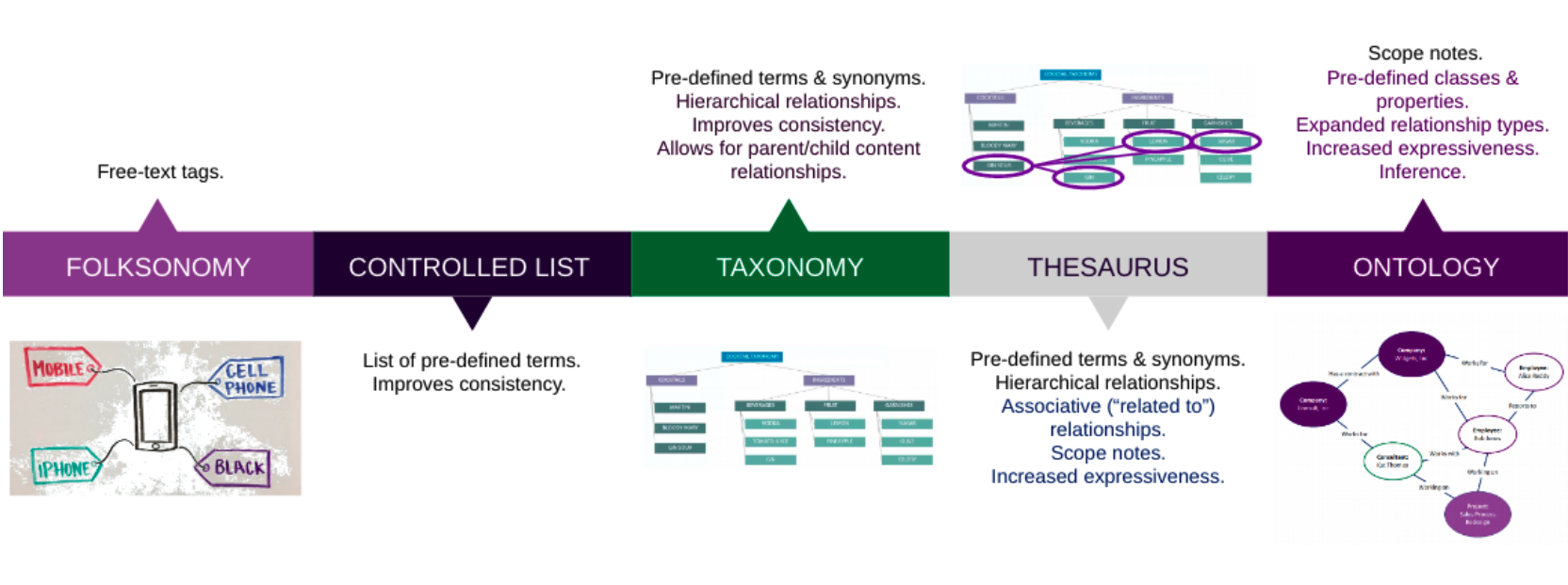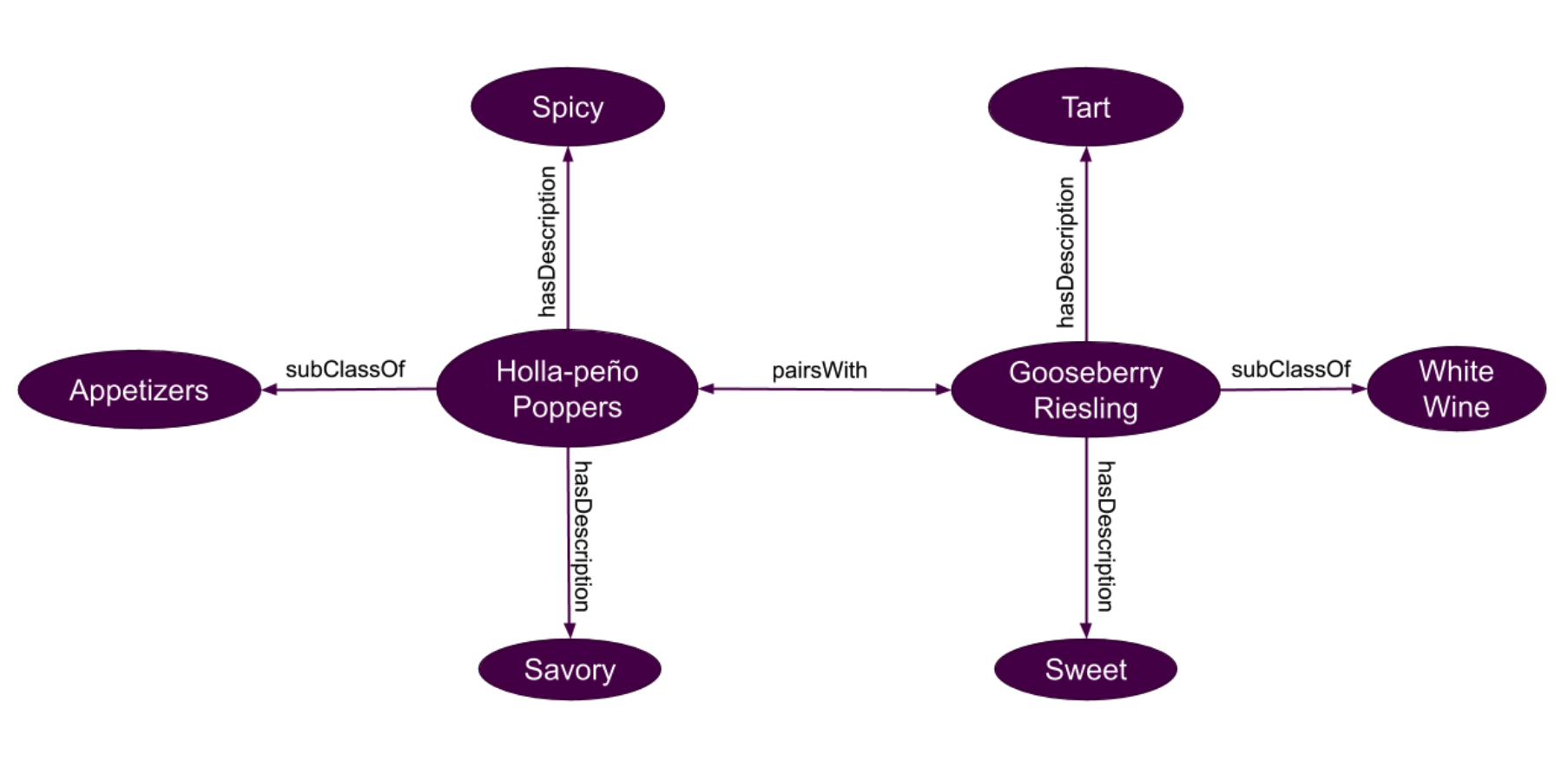Taxonomies and ontologies are both types of Knowledge Organization Systems, or KOS. Different types of KOS can be seen as a continuum, starting with a simple folksonomy where users of content can add free form tags with no control or curation, to taxonomies, thesauri, and ontologies that are often more complex and require detailed design. Ontologies are the far right of the continuum and require the most effort in design, control, and curation, but also provide the most flexibility in terms of describing the content and relationships between other data and content. Many organizations fall into the middle of the spectrum and are already designing and utilizing taxonomies. At this stage, they are well poised to leverage an existing taxonomy to design an ontology of their domain. By designing an ontology, they will gain flexibility and the ability to describe additional relationships outside of the traditional hierarchy or parent/child relationships of a taxonomy or thesaurus.
Here at EK, we classify an ontology as “a defined model that organizes structured and unstructured information through entities, their properties, and the ways that they relate to one another.” In other words, an ontology lets us describe a domain by defining a vocabulary to describe all the “things” that make up the domain, properties or metadata about the “thing,” and how “thing A” relates to “thing B”. Ontologies deliver many benefits, including enabling data interoperability, merging unstructured and structured information, improving the findability and discoverability of information, and creating the ability to use inferences and improved recommendations specific to the domain being described.
Let’s take the fictional company, Wine Shop, as an example of how an existing taxonomy can be leveraged as a starting point to design an ontology. Wine Shop is an international retailer of premium wines and other alcoholic beverages. Wine Shop also sells small plates and appetizers that complement their wines, but these plates only make up a small portion of their sales. Michael, the lead taxonomist for Wine Shop, has already developed and implemented an expressive and complete taxonomy describing the domain of wine and other alcoholic beverages, as well as a basic taxonomy describing Wine Shop’s food offerings. These taxonomies allow shoppers to navigate Wine Shop’s online catalog of food and beverages through faceted searching and browsing. Sales of wine have been steadily increasing ever since the implementation of the taxonomy. However, food sales have remained low.
One option suggested by the marketing team to boost food sales is to show customers which food items pair well with a given wine that they may be interested in, particularly through their online shopping cart. In order to create recommendations for foods that complement specific beverages, Michael first needs to define relationships between wines and complementary foods based on taste, scent, or region.
The first step is to create additional taxonomy facets for the attributes (taste, scent, or region) that will be used to describe the food and beverages. This is where the existing taxonomy becomes the starting point for the ontology. The existing metadata fields in the wine taxonomy, such as brand or type of wine, will become entities, or “things,” in the ontology. These entities will be related to each other and to additional entities through new and existing terms that define the characteristics of the wine or snacks. For example, the controlled list of regions where the wine is made is both a metadata field in the original taxonomy and will also be used to define the range of values allowed for the relationship madeIn. In the ontology, madeIn will be used to relate a region, Napa, with the wine, Cabernet Sauvignon. Once the taxonomy has been expanded, Michael and his team can begin to map food and beverage items to their corresponding attributes.
Michael and team begin to map the properties and attributes of the Gooseberry Riesling, one of their best sellers, and the Holla-peño Poppers appetizer, which pairs with the Gooseberry Riesling, but isn’t often purchased. This mapping is done via drawing explicit relationships between each item and the flavor taxonomy to show that, for example, the Riesling has Description “Sweet” and the Holla-peño Poppers hasDescription “Spicy.” Now that the attributes of each object (item) have been defined, Michael defines a relationship, “pairsWith,” to note that the Gooseberry Riesling pairsWith Holla-peño Poppers. Now, when a customer puts Gooseberry Riesling wine into their cart, the website will suggest that they may also want to buy the Holla-peño Poppers.
In this case, Wine Shop’s ontology of wines and appetizers is being used as a recommender in which it recommends pairings to increase related product sales. In the example above, Michael explicitly pairs the Gooseberry Riesling and Holla-peño Poppers using the pairsWith relationship. However, Michael can also map pairings between attributes such as flavors and descriptions, showing that the “spicy” flavor pairsWith the“sweet” flavor. He can then use ontological inferences to suggest any spicy appetizer pairsWith a sweet, white wine, uncovering new pairings that may not be immediately obvious, even to the marketing experts at Wine Shop.
Although you might not be in the business of selling wine and snacks, you can see how these capabilities are applicable to any business. This same method can be used to define relationships and yield recommendations for your organization’s products, services, or knowledge (both internal and external). Wouldn’t it be powerful if your internal experts were linked through ontological relationships to the content they create, as well as to their fields of expertise? In that instance, other documents in the same field or by the same author can be recommended to an information seeker to further their learning and knowledge and better serve their customers or colleagues.
Want help designing an ontology to describe and recommend your products, documents on your intranet, or an expert profile? Learn more on how we can help and contact us at info@enterprise-knowledge.com.


